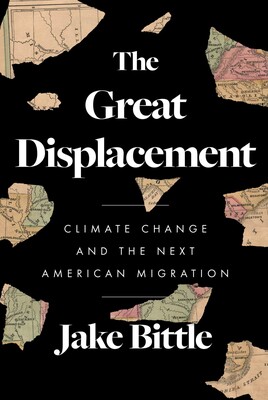The Great Displacement: Climate Change and the Next American Migration
- By Jake Bittle
- Simon & Schuster
- 368 pp.
- Reviewed by John R. Wennersten
- March 20, 2023
Is the U.S. ready for the coming storm?

In The Great Displacement, Jake Bittle offers us an informed but disquieting picture of the impact of climate change on the American people as we move forward in the 21st century. “For a long time,” he writes, “climate change was something to be discussed in abstract terms, something that existed in the future tense.” But we’re now living at a time when one in three Americans has experienced an unnatural weather disaster of some kind.
Bittle offers a number of human-interest stories of families forced to leave their hurricane-ravaged ancestral bayou homes in Louisiana, flooded suburban tracts in Houston, drought-stricken ranches in Arizona, and fire-ravaged communities in northern California. Closer to Washington, DC, rising tides are a regular occurrence in Norfolk, Virginia, that threaten everything from private estates and churches to the biggest naval base in the United States.
The author writes that climate change induces shifts of population that are often as chaotic as the weather events prompting them. People don’t want to leave their homes following a weather disaster; they want to rebuild. But as flood and fire insurance from FEMA and private companies becomes prohibitively expensive, they will have no choice but to migrate — in most cases, to more urban areas where they can find reasonable housing and employment. Refugees from the charred ruins of Santa Rosa, California, move to Boise, Idaho; those from the hurricane-devastated Florida Keys make for Orlando; and waterless irrigation farmers head northward to cooler, wetter climes.
Some climate migration will be voluntary, as the affluent seek higher or safer ground. The not-so-rich, whose livelihoods or lives are in jeopardy, will be left to deal as best they can, usually fleeing one endangered area or flood plain for another.
The two approaches to climate-change living will be “managed retreat” by government-sponsored withdrawal from the most volatile areas, or choosing to reside in areas fortified by dikes and flood barriers or free of trees and scrub brush. There is another approach from history, however, that seems to be forgotten: People should not live in dangerous areas in the first place.
The great explorer John Wesley Powell admonished Americans way back in the 19th century to stay out of the arid lands of the desert Southwest. It was simply too dry and barren to sustain homesteading, he insisted. Others have similarly warned against building housing communities on flood plains or in volatile mountain regions prone to wildfires. But people didn’t listen.
Dramatic climate events will continue to bring about transformations of habitat that destroy local cultures and cause staggering demographic adjustments. Those who have forgotten the Dust Bowl — a period of devastation caused by chronic drought and the over-farming of the Great Plains — are destined to repeat it.
In the future, writes Bittle, a kind of racist logic will come into play, with expensive engineering being used to protect wealthy communities from extreme weather events while the Black and brown and poorer whites are left to survive on cheap buyouts insufficient to allow them to move to “safe” areas. Such buyouts, Bittle adds, also tend to destroy neighborhoods and destabilize lives.
So, where will the people whose lives have been upended by climate disasters go? This is not just a question for Americans; it’s a global dilemma. As of today, millions of people worldwide are on the move. Some flee oppression. Others flee lands being drowned by the sea or baked by the sun. Still others flee poverty, disease, and war.
The United Nations predicts that, in a few decades, some 50 million people will be climate migrants. This deluge of migration is starting to crash on our shores even as America has its own domestic climate refugees to deal with. What happens when Miami becomes Venice? It likely will, albeit gradually. Climate change occurs incrementally. One day, we’re walking on dry land. The next, our flooded basements force us to accept that “unprecedented” weather events no longer are.
Bittle cites familiar solutions to counter the coming great displacement of his title: a reduction in the use of fossil fuels and a “ramp up of our investment in post-disaster and climate adaptation,” both of which are dependent on political will. Finally, he argues in this well-written work that deserves a wide readership, we must “reimagine how we are going to live” in an environment for which America is largely unprepared. Only time will tell if we can.
[Editor’s note: Jake Bittle will appear at this year’s Gaithersburg Book Festival on May 20th in Gaithersburg, MD. Learn more here.]
John R. Wennersten is Emeritus Professor of American history at the University of Maryland, Eastern Shore and the author of Rising Tides: Climate Refugees in the Twenty-first Century.

